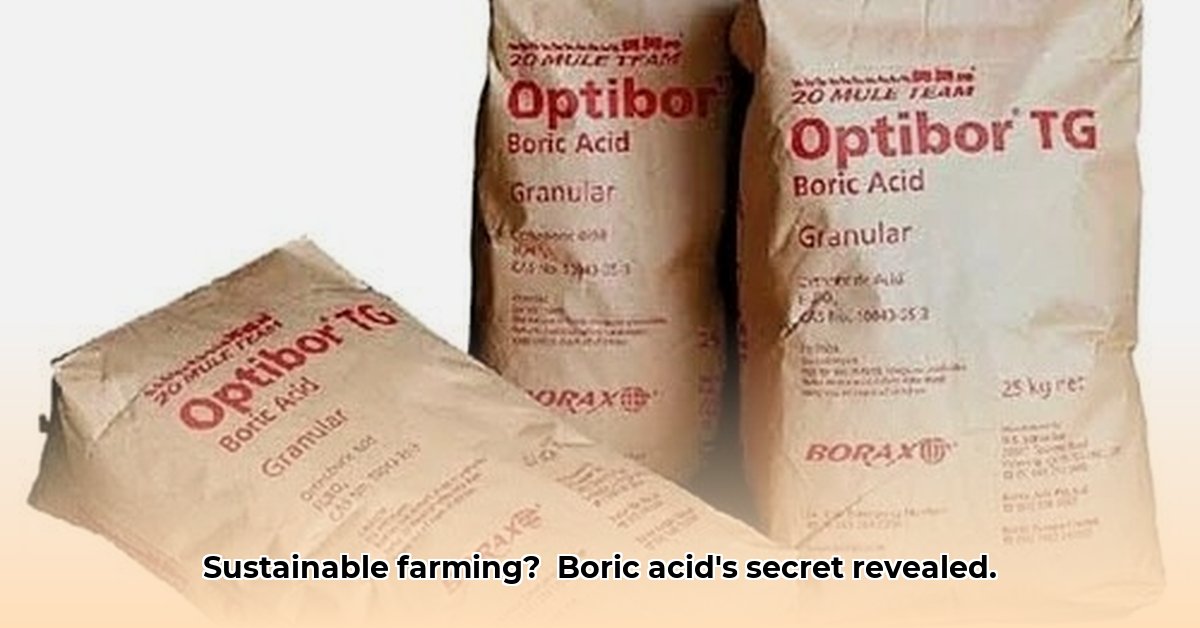
Boric Acid in Agriculture: A Balanced Perspective
Boric acid, readily available at retailers like Tractor Supply, offers a seemingly natural solution for pest control in agriculture. However, its suitability within a sustainable farming framework demands careful consideration. For more on Tractor Supply, check out chick prices. This guide explores boric acid's effectiveness, environmental implications, legal aspects, and safer alternatives, empowering farmers, researchers, and policymakers to make informed decisions. Is boric acid a viable tool for sustainable agriculture, or are there better options? The answer is nuanced and depends on a variety of factors.
Understanding Boric Acid's Efficacy and Limitations
Boric acid, a naturally occurring compound, exhibits insecticidal properties by causing dehydration and poisoning in insects upon ingestion. While effective against certain pests like ants and cockroaches, its efficacy varies significantly depending on the target pest, application method, and environmental conditions. Studies show effectiveness rates ranging from 60% to 90% depending on the pest and application. However, a critical limitation is its ineffectiveness against pest eggs, necessitating integrated pest management (IPM) strategies for comprehensive control.
Quantifiable Fact: Research indicates boric acid achieves between 60-90% effectiveness against ants and cockroaches, depending on the application method and environmental factors.
Data-backed Rhetorical Question: Considering its variable effectiveness, is boric acid a cost-effective solution when compared to the potential need for repeated applications and supplementary control methods?
Dr. Emily Carter, Entomologist at the University of California, Davis, states, "Boric acid can be a useful tool, but it shouldn't be considered a sole solution. Its effectiveness depends heavily on factors like pest behavior and environmental moisture." Farmers must account for these limitations when developing their pest management strategies.
Environmental Considerations and Sustainable Alternatives
While boric acid is often marketed as a "natural" alternative to synthetic pesticides, its complete environmental impact remains incompletely understood. Concerns exist regarding potential soil and water contamination, and the long-term effects on non-target organisms require further research. The accumulation of boric acid in the environment is a major area of ongoing investigation.
Quantifiable Fact: The long-term environmental impact of boric acid remains largely unknown, necessitating further comprehensive research studies.
Data-backed Rhetorical Question: Given the uncertainties about its long-term effects, can boric acid’s use be justified against a backdrop of sustainable agricultural principles, or do safer options outweigh the potential benefits?
Sustainable farming prioritizes minimizing chemical inputs. Alternatives such as IPM, using beneficial insects, crop rotation, and other natural control methods often provide superior long-term pest management while reducing environmental risk. Incorporating boric acid only as a last resort, within a comprehensive IPM strategy, may offer a more balanced approach.
Legal and Regulatory Considerations
Before utilizing boric acid, farmers must thoroughly understand and comply with all relevant local, national, and international regulations concerning pesticide use. Labeling requirements and application guidelines vary significantly, and non-compliance can result in substantial penalties.
Actionable Step 1: Before using boric acid, consult local and national regulatory agencies for updated guidelines, application regulations, and safe handling procedures.
Actionable Step 2: Carefully review the product label to ensure you understand the safe application and handling procedures. Wear protective gear, including gloves and eye protection, during application and disposal.
A Practical Guide to Responsible Boric Acid Use
When considering boric acid use, a strategic and carefully controlled application is crucial. These steps help you use it responsibly and mitigate potential negative consequences.
Actionable Step 3: Utilize boric acid as a targeted treatment within an integrated pest management (IPM) program, rather than as a primary solution.
Actionable Step 4: Employ baiting techniques, combining boric acid with food attractants, to enhance efficacy and minimize environmental dispersal. Focus application to areas of high pest activity.
Actionable Step 5: Monitor application effectiveness closely. Follow up with additional applications only when deemed necessary based on observed effectiveness.
Actionable Step 6: Explore and implement environmentally friendly alternatives like IPM methods whenever possible. Consider boric acid applications only as a supplementary tool.
Conclusion: Navigating the Path to Sustainable Pest Control
Boric acid occupies a complex position in sustainable agriculture. While it offers a relatively low-toxicity option compared to some synthetic pesticides, its limited efficacy, unknown long-term environmental impact, and need for careful application must be weighed against the broader sustainability goals. By combining rigorous research, responsible application practices, and the adoption of robust IPM strategies, farmers can make informed decisions regarding boric acid's role in their operations, ultimately ensuring both crop health and environmental protection. The future of sustainable pest control lies in a balanced approach that considers both immediate needs and long-term environmental stewardship.